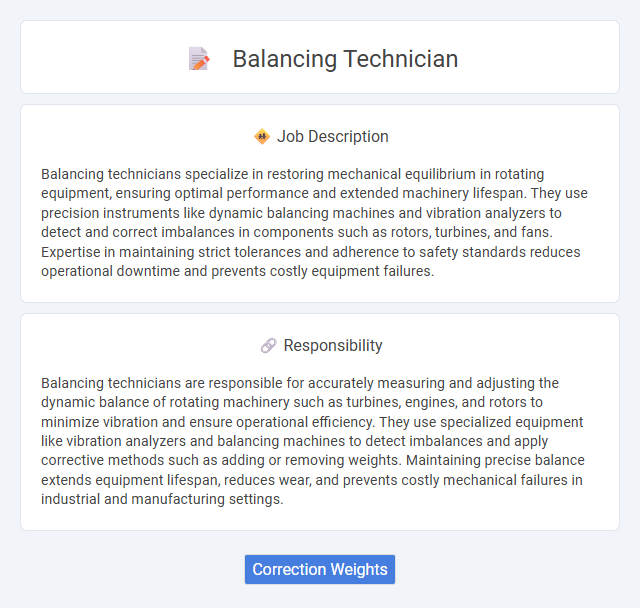
Balancing technicians specialize in restoring mechanical equilibrium in rotating equipment, ensuring optimal performance and extended machinery lifespan. They use precision instruments like dynamic balancing machines and vibration analyzers to detect and correct imbalances in components such as rotors, turbines, and fans. Expertise in maintaining strict tolerances and adherence to safety standards reduces operational downtime and prevents costly equipment failures.
People with strong problem-solving skills and attention to detail are likely to be well-suited for a balancing technician job, as it requires precise measurement and adjustment of mechanical components. Those who have good manual dexterity and can work in physically demanding environments might find this role compatible with their abilities. Conversely, individuals who struggle with repetitive tasks or prefer sedentary work may find this position less suitable.
Qualification
Balancing technicians require specialized knowledge in vibration analysis, dynamic balancing principles, and the use of precision balancing equipment to ensure machinery operates efficiently and safely. Qualifications typically include a high school diploma or equivalent, technical training in mechanical or industrial maintenance, and certifications such as those from the Vibration Institute or National Institute for Certification in Engineering Technologies (NICET). Proficiency in interpreting technical diagrams and adherence to industry safety standards enhances a balancing technician's effectiveness in diagnosing and correcting equipment imbalances.
Responsibility
Balancing technicians are responsible for accurately measuring and adjusting the dynamic balance of rotating machinery such as turbines, engines, and rotors to minimize vibration and ensure operational efficiency. They use specialized equipment like vibration analyzers and balancing machines to detect imbalances and apply corrective methods such as adding or removing weights. Maintaining precise balance extends equipment lifespan, reduces wear, and prevents costly mechanical failures in industrial and manufacturing settings.
Benefit
Balancing technician jobs likely offer significant benefits, including enhanced precision in machinery performance, which can reduce operational downtime. These roles probably contribute to improved safety by minimizing vibrations that cause mechanical failures. Professionals in this field may experience steady demand and competitive salaries due to their specialized expertise.
Challenge
Balancing technician jobs likely present challenges related to precision and attention to detail, as even minor errors can affect machinery performance. The role probably requires strong problem-solving skills to quickly identify and correct imbalances that may cause operational inefficiencies. Time management may also be a significant challenge, with technicians needing to meet tight deadlines while ensuring equipment safety and functionality.
Career Advancement
Balancing technicians gain specialized expertise in vibration analysis, precision measurement, and rotor dynamics essential for machine maintenance and performance optimization. Advanced certifications in dynamic balancing and condition monitoring increase job prospects and open pathways to senior roles such as vibration analyst or maintenance supervisor. Continuous skills development in cutting-edge balancing technology and predictive maintenance tools significantly enhances career growth and salary potential.
Key Terms
Correction Weights
Correction weights are essential in balancing technician jobs as they ensure precise adjustment of rotating machinery to prevent vibrations and wear. Technicians calculate the exact mass and placement of these weights to counteract imbalance forces, optimizing equipment performance and extending its lifespan. Accurate application of correction weights reduces downtime and maintenance costs in industrial settings.
 kuljobs.com
kuljobs.com